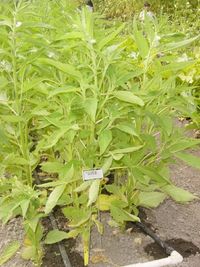Sesame
2007 Schools Wikipedia Selection. Related subjects: Food and agriculture; Plants
| iSesame | ||||||||||||||
|---|---|---|---|---|---|---|---|---|---|---|---|---|---|---|
 Sesame plants
|
||||||||||||||
| Scientific classification | ||||||||||||||
|
||||||||||||||
|
|
||||||||||||||
| Sesamum indicum L. |
Sesame (Sesamum indicum) is a flowering plant in the genus Sesamum. The precise natural origin of the species is unknown, although its closest relatives occur in Africa. It is widely naturalised in tropical regions around the world and is cultivated for its edible seeds.
It is an annual plant growing to 50-100 cm tall, with opposite leaves 4-14 cm long with an entire margin; they are broad lanceolate, to 5 cm broad, at the base of the plant, narrowing to just 1 cm broad on the flowering stem. The flowers are white to purple, tubular, 3-5 cm long, with a four-lobed mouth.
The word sesame is from Latin sesamum, borrowed from Greek sēsámon "seed or fruit of the sesame plant", borrowed from Semitic (cf. Aramaic shūmshĕmā, Arabic simsim), from Late Babylonian *shawash-shammu, itself from Assyrian shamash-shammū, from shaman shammī "plant oil".
Cultivation and uses
Sesame is grown primarily for its oil-rich seeds, which come in a variety of colors. The small, cream-white sesame seed is used whole in cooking for its rich nutty flavour (although such heating damages their health-giving poly-unsaturated fats), and also yields a cooking oil. Sesame seeds are sometimes added to breads, including bagels and the top of hamburger buns. Sesame seeds are baked into crackers, often in the form of sticks.
Sesame seeds can be made into a paste called tahini (used in hummus) and a Middle Eastern confection called halvah. In India, sections of the Middle East and East Asia, popular treats are made from sesame mixed with honey or syrup and roasted (called pasteli in Greece). Sesame oil was the preferred cooking oil in India till the advent of groundnut (peanut) oil. Sesame flavour (through oil and roasted or raw seeds) is also very popular in Korean cuisine, used to marinate meat and vegetables. Sesame seeds are also sprinkled onto some sushi style foods. East Asian cuisines, like Chinese cuisine uses sesame seeds and oil in some dishes, such as the dim sum dish, sesame seed balls ( Traditional Chinese: 麻糰; pinyin: mátuǎn).
Japanese cuisine uses sesame seeds in many ways. One is to make goma-dofu (胡麻豆腐) which is made from sesame paste and starch. Whole seeds are found in many salads and baked snacks as well. Chefs in tempura restaurants blend sesame and cottonseed oil for deep-frying. Tan and black sesame seed varieties are roasted and used for making the flavoring called gomashio.
The seeds are rich in manganese, copper, and calcium (90 mg per tablespoon for unhulled seeds, only 10 mg for hulled seeds), and contain Vitamin B1 (thiamine) and Vitamin E (tocopherol). They contain powerful antioxidants called lignans, which are also anti-carcinogenic. They also contain phytosterols, which block cholesterol production. Sesame contains one lignan unique to it called sesamin. The nutrients of sesame seeds are better absorbed if they are ground or pulverised before consumption.
Sesame is used as a food plant by the larvae of some Lepidoptera species including Turnip Moth.
Sesame oil is used for massage and health treatments of the body in the ancient Indian ayurvedic system with the types of massage called abhyanga and shirodhara. Ayurveda views sesame oil as the most viscous of the plant oils and as such good at pacifying the health problem associated with vata aggravation.
Although sesame leaves are edible as a potherb , recipes for Korean cuisine calling for "sesame leaves" are often a mistranslation, and really mean perilla .
|
Thai workers harvesting sesame |


